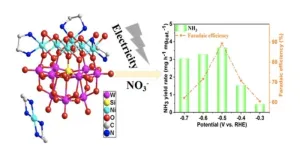(Press-News.org) “We often hear that obesity represents a high cost for both individuals and society because it increases the risk of health problems. All in all, however, the costs associated with being overweight are much higher,” says Christina Hansen Edwards, a researcher at the Norwegian University of Science and Technology (NTNU).
Since the 1980s, Norwegians have become increasingly heavier. Over the past 40 years, the percentage of people with obesity, i.e. a body mass index (BMI) of over 30, has increased significantly. It is currently estimated that almost one in four Norwegians is obese, which is comparable to obesity rates throughout Europe.
However, the number of people who are ‘only’ overweight has also increased. During the period 1980 to 2000, the average BMI of the population increased by one point every decade.
“We are seeing a shift in the entire population towards a higher BMI. People with a BMI in the ‘normal range’ have also gained weight,” says Edwards.
The researchers have now looked at the relationship between BMI and costs in the specialist health service.
“Although the individual costs are highest for people who are obese, the total costs for society are highest in relation to people who are overweight, since there are many more people who are overweight than obese," says Gudrun Maria Waaler Bjørnelv, a researcher at NTNU’s Department of Public Health and Nursing.
Population-level measures needed
In other words, although the risk of disease is higher if your BMI is over 30, the overall risk of disease in the entire population will be greater with a BMI of over 25. This is because the vast majority of people find themselves within this range on the scale.
Edwards thinks it is important for politicians to be aware of this when managing health and societal resources.
“People with obesity need good treatment from the health services. However, in order to ease the burden of disease and the costs of overweight and obesity in the entire population, individualized treatment should be combined with effective measures at the population level,” says Edwards.
The study is based on figures from the HUNT Study – a longitudinal population health study in Norway. It shows that 75 per cent of men and 61 per cent of women were overweight or obese.
Of these, 3.7 per cent of men and 6.6 per cent of women had a BMI of over 35, while 22.4 per cent of men had a waist measurement of more than 102 cm, and 23.4 per cent of women had a waist measurement of over 88 cm.
“At the individual level, we saw that an increase in BMI resulted in the greatest increase in expenses for the specialist health services among those who previously had the highest BMI. If one compares a man with a BMI of 37 to a man with a BMI of 38, on average, the latter will result in NOK 2110 (roughly US $210) more in average costs for the specialist health services per year. A similar difference in men with a BMI of 27 and 28 respectively will only result in an increase of NOK 293 (approximately US$ 29)," Edwards said.
Should not feel ashamed
Similar comparisons among women show differences of NOK 1306 (US $130) and NOK 277 (US $28), respectively. However, when the researchers look at the figures for the population as a whole, the picture changes.
“At the societal level, by contrast, we see that the largest increase in costs for the specialist health services was due to changes in BMI in people that were ‘only’ overweight, i.e. they had a BMI of between 25 and 30, as well as in those with mild obesity, i.e. a BMI of between 30 and 35. This was true for both women and men,” says Bjørnelv.
She emphasises that the point of the comparison is not primarily to save the health service money, but that the specialist health service costs reflect the burden of disease, both in individuals and in society.
"People with obesity should not feel ashamed that they cost society money," Bjørnelv said.
“Obesity is often portrayed as expensive for society,” he said, referring to the Norwegian Broadcasting Corporation's series ‘A fat life’.
In this TV series, host Ronny Brede Aase uses himself and his own body to shed light on questions about obesity, lifestyle and health. In the series, Aase says that he is "an expenditure," which Bjørnelv says is not necessarily correct.
“People with obesity should not feel ashamed that they cost society money. Although they are at higher risk of disease, the highest specialist health service costs result from those who are overweight," he said. “We don’t want people who are overweight to feel ashamed because of that, but we need to be reflective in how we shed light on the issue and how we deal with this as a society."
Recent research has shown that people with a high BMI have an increased likelihood of being stigmatized and discriminated against, also in the healthcare system.
"This can cause people with a high BMI to avoid the use of health services, so that they receive poorer health services and the relationship between doctor and patient is damaged. This is a field where there is a clear need for more research, for example on how stigma affects the costs of health services in the longer term," Bjørnelv said.
Consensus on risk
The researchers are also keen to emphasise that BMI as a unit of measurement is primarily important when looking at overweight and obesity in groups, and not in each individual.
“BMI alone is not a suitable measuring unit at an individual level, but at a population level it can give a good picture of obesity and overweight," Edwards said.
She clarifies that the results in the study are average costs for different BMI values, and that there are variations around this average. A single person with a given BMI will therefore not be able to use these results to say anything about own costs.
It is also not a given that being overweight leads to health problems.
"This is where the variation comes in. A person with a BMI of 33 does not necessarily have higher costs for health services than a person with a BMI of 23. But if we look at the average of all people with a BMI of 33 and 23, then people with a BMI of 33 have higher costs for health services than those with BMI of 23," she said.
It would therefore be more appropriate to direct measures to the entire population.
BMI is thus primarily a useful unit of measurement at the population level, and less useful for individuals.
"In our study, we investigated the relationship between BMI and healthcare costs," she said.
Although this relationship can be influenced by many different factors, there is broad agreement among researchers that an increase in BMI increases the risk of a number of diseases, Edwards said.
It would therefore be appropriate to implement measures that target the entire population the researchers concluded.
“The challenge then is finding out which measures work,” says Edwards.
So, what should health policymakers do? Bjørnelv and Edwards believe it is important that studies are conducted on the effectiveness of national public health measures.
"The measures that were introduced as part of the Smoking Act were unpopular when they were introduced, but eventually this turned around completely. Similar measures, such as advertising bans, taxation, and access restrictions on unhealthy food, could have been tested to overcome the obesity pandemic. This requires brave politicians who dare to take controversial decisions," Edwards said.
Reference:
Christina Hansen Edwards, Gudrun Waaler Bjørnelv, Karsten Øvretveit, Kristian Hveem, Johan Håkon Bjørngaard: Healthcare costs associated with overweight and obesity at an individual versus a population level – a HUNT study. The Journal of the Norwegian Medical Association. Published 19 September 2023
doi: 10.4045/timeskr.22.0726
END
Being overweight costs society far more than obesity
Far more people are overweight than obese, which means their overall use of the health care system may be far larger than for those who are heavier.
2023-12-14
ELSE PRESS RELEASES FROM THIS DATE:
People, not the climate, caused the decline of the giant mammals
2023-12-14
About 100,000 years ago, the first modern humans migrated out of Africa in large numbers. They were eminent at adapting to new habitats, and they settled in virtually every kind of landscape - from deserts to jungles to the icy taiga in the far north.
Part of the success was human's ability to hunt large animals. With clever hunting techniques and specially built weapons, they perfected the art of killing even the most dangerous mammals.
But unfortunately, the great success of our ancestors came at the expense of the other large mammals.
It is well-known that numerous large species went extinct ...
Children who are sedentary may have a higher risk of heart attack or stroke later in life
2023-12-14
WASHINGTON—Children who are physically inactive may have high cholesterol in early adulthood and subsequent heart health issues in their mid-forties, according to new research published in The Journal of Clinical Endocrinology & Metabolism.
High cholesterol during childhood has been associated with early signs of heart disease when individuals reach their mid-twenties and an increased risk of premature cardiovascular death in their mid-forties. Several clinical trials aimed at lowering cholesterol levels in the youth population have had minimal ...
Cockroaches can transmit antimicrobial resistance genes between groups
2023-12-14
Washington, D.C.—A new paper describes a study of antimicrobial resistance (AMR) transmission among cockroaches, with implications for AMR transmission in humans. The study was published in mSystems, a journal of the American Society for Microbiology.
AMR represents a serious threat to the health of humans and other animals. With fewer and fewer drugs being effective against some microbial pathogens, infections have become increasingly difficult to treat. Theoretical modeling has been used to explore the spread of AMR through the microbiome of the symbiotic, or nonpathogenic, gut of animals. The present study ...
Three novel inorganic clusters accelerate ‘one of the most important’ chemical reactions
2023-12-14
Perfume, rubbing alcohol, a cholesterol medication and even biological processes all depend on a chemical process called the aldol reaction. The reaction primarily combines compounds to form carbon-carbon bonds, which are incredibly strong and provide a molecule with stability. Catalyst clusters made of aluminum and oxygen typically help accelerate this reaction, but clusters that also include rare earth elements could offer more desirable and synergistic properties, according to a team of researchers based in China.
The team developed three such clusters, ...
Unlocking the human genome: Innovative machine learning tool predicts functional consequences of genetic variants
2023-12-14
New York, NY [December 14, 2023]—In a novel study, researchers from the Icahn School of Medicine at Mount Sinai introduced LoGoFunc, an advanced computational tool that predicts pathogenic gain- and loss-of-function variants across the genome.
Unlike current methods that predominantly focus on loss of function, LoGoFunc distinguishes among different types of harmful mutations, offering potentially valuable insights into diverse disease outcomes. The findings were described in the November 30 online issue of Genome Medicine ...
A new catalyst opens efficient conversion from nitrate pollution to valuable ammonia
2023-12-14
Pollution spewing from a booming global economy poses a number of different threats to human health. Researchers from Zhongyuan University of Technology proposed a new possible avenue to efficiently convert nitrate, a widespread water pollutant, back to valuable ammonia. In their recently published study, the team outlined a novel path to efficiently convert nitrate to ammonia using metal-added polyoxometalate as the catalyst under mild operating conditions.
The study was published December 8 in Polyoxometalates.
In the past few decades, a number of methods have been deployed ...
High cholesterol caused by childhood sedentariness could be reversed with light physical activity
2023-12-14
Strictly embargoed until 0900 ET Thursday 14 December 2023
Increased sedentary time in childhood can raise cholesterol levels by two thirds as an adult, leading to heart problems and even premature death - but a new study has found light physical activity may completely reverse the risks and is far more effective than moderate-to-vigorous physical activity.
The study was conducted in collaboration between the University of Exeter, University of Eastern Finland, and University of Bristol and published in The Journal of Clinical Endocrinology & Metabolism. Researchers used data from the University of Bristol study Children of the 90s (also known as the Avon Longitudinal Study of Parents ...
Menstrual cycles affect day-to-day suicide risk, UIC researchers find
2023-12-14
Female patients with a history of suicidality experience an increased risk of suicidal ideation or suicidal planning in the days surrounding menstruation, according to a new study by researchers at the University of Illinois Chicago.
In the first longitudinal study of how suicidal thoughts and related symptoms fluctuate across the menstrual cycle, UIC researchers identified when some female patients are at the highest risk, offering new guidance for clinicians about when to focus interventions with suicidal patients.
“As clinicians, we feel responsible for keeping our patients safe from a suicide attempt, but we often don’t have much information about when we need ...
A novel low-cost unmanned aerial vehicle platform for electrical transmission line inspection
2023-12-14
Electricity is an indispensable resource for our daily lives; it powers our homes, industries, and agriculture, among other things. Electricity is generated in power plants that are often located in remote areas due to safety and environmental concerns. The generated electricity is then transported to residential and industrial areas through transmission lines. However, these remote locations pose challenges in terms of harsh environments that can easily damage the transmission lines. Therefore, regular inspection and maintenance of these lines are ...
Popular blood thinner associated with higher risk of bleeding complications
2023-12-14
When diagnosed with a blood clot or atrial fibrillation, patients are often prescribed anticoagulants, or blood thinners, to prevent a future clot.
In a study of the three most commonly prescribed blood thinners, the oral anticoagulant rivaroxaban, known by the brand name Xarelto, was associated with a significantly higher risk of bleeding complications than apixaban (brand name Eliquis) and warfarin for patients with blood clots or atrial fibrillation.
The findings, reported at the 2023 American Society ...
LAST 30 PRESS RELEASES:
Tracing the quick synthesis of an industrially important catalyst
New software sheds light on cancer’s hidden genetic networks
UT Health San Antonio awarded $3 million in CPRIT grants to bolster cancer research and prevention efforts in South Texas
Third symposium spotlights global challenge of new contaminants in China’s fight against pollution
From straw to soil harmony: International team reveals how biochar supercharges carbon-smart farming
Myeloma: How AI is redrawing the map of cancer care
Manhattan E. Charurat, Ph.D., MHS invested as the Homer and Martha Gudelsky Distinguished Professor in Medicine at the University of Maryland School of Medicine
Insilico Medicine’s Pharma.AI Q4 Winter Launch Recap: Revolutionizing drug discovery with cutting-edge AI innovations, accelerating the path to pharmaceutical superintelligence
Nanoplastics have diet-dependent impacts on digestive system health
Brain neuron death occurs throughout life and increases with age, a natural human protein drug may halt neuron death in Alzheimer’s disease
SPIE and CLP announce the recipients of the 2025 Advanced Photonics Young Innovator Award
Lessons from the Caldor Fire’s Christmas Valley ‘Miracle’
Ant societies rose by trading individual protection for collective power
Research reveals how ancient viral DNA shapes early embryonic development
A molecular gatekeeper that controls protein synthesis
New ‘cloaking device’ concept to shield sensitive tech from magnetic fields
Researchers show impact of mountain building and climate change on alpine biodiversity
Study models the transition from Neanderthals to modern humans in Europe
University of Phoenix College of Doctoral Studies releases white paper on AI-driven skilling to reduce burnout and restore worker autonomy
AIs fail at the game of visual “telephone”
The levers for a sustainable food system
Potential changes in US homelessness by ending federal support for housing first programs
Vulnerability of large language models to prompt injection when providing medical advice
Researchers develop new system for high-energy-density, long-life, multi-electron transfer bromine-based flow batteries
Ending federal support for housing first programs could increase U.S. homelessness by 5% in one year, new JAMA study finds
New research uncovers molecular ‘safety switch’ shielding cancers from immune attack
Bacteria resisting viral infection can still sink carbon to ocean floor
Younger biological age may increase depression risk in older women during COVID-19
Bharat Innovates 2026 National Basecamp Showcases India’s Most Promising Deep-Tech Ventures
Here’s what determines whether your income level rises or falls
[Press-News.org] Being overweight costs society far more than obesityFar more people are overweight than obese, which means their overall use of the health care system may be far larger than for those who are heavier.




